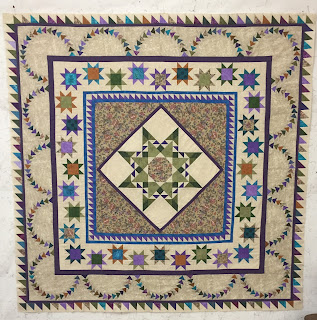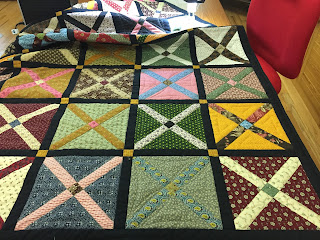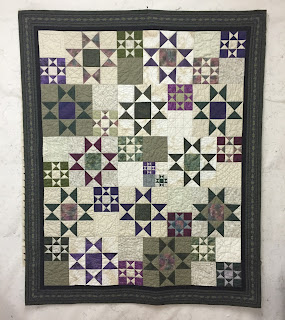Mine are totally scrappy, using the fabrics I used in the curved flying geese.
I know some people really do not like paper piecing. This border is one you can easily choose to piece in the regular fashion. I did that with the left border. Then I used paper piecing for the right border so I could choose which method I preferred for the top and bottom borders--more on that later.
Here are some tips for piecing the half square triangles (HST) by regular piecing. There are several different methods you can use, I'll show you what I did. IF you are making the HST from only one fabric, it would be faster to use a grid method to create a bunch of them at one time. I will discuss using a HST ruler and how to make HST from squares--there are detailed photos of both those methods on an earlier blog I did for our Sew-A-Long, earlier this year.
I like to use a half-square triangle ruler; there are several brands. The one I use is from Creative Grids, CGRT45. The advantages to this method are:
1. It uses less fabric--for 1.5" finished HST, strips are cut 2".
2. It is easy to check completed sizes as you sew.
3. It's not paper-pieced, important if that is not your "thing".
The disadvantages:
1. It may be slower.
2. The seam allowance is critical.
3. You make the units, then sew them into a border, two different steps.
Here I have 2" strips of a lavender and background, placed Right Sides Together. With this ruler you place the line that corresponds to the cut size of the strip on the bottom--each ruler has it's own instructions, some use the finished size of the HST, so be sure you know which line to use with your ruler:
 |
| Ready for the first cut |
 |
| Ready for the second cut |
 |
| Two HST ready to be chain pieced |
 |
| "Chain, chain, chain..." |
 |
| A bunch of HST chain pieced |
 |
| An easy way to separate the units--a Clover thread cutting disc set in a child's wooden block |
 |
| A new tool: Sunflower Quilts thread cutter, new to the Market |
 |
| Pressed toward the darker fabric and ready to trim |
I use a very scant seam allowance with units this size, more than an 1/8", less than a 1/4". It works for me. That makes these units a tad bit larger than 2" so I get to "Trim to Perfection". Above is the first trimming, below I have rotated the unit 180 degrees and trimmed the other side:
 |
| A bunch of perfect 2" unfinished HST |
Once you have 34 HST you are ready to sew them into the Left border:
Here is the most important tip: As you make pairs, check to be sure they are 3.5" unfinished. You will see quickly if your seam allowance is too narrow or to wide. Then join those pairs into units of 4--these should be 6.5", check to be sure. Then two units of 4 become 12.5". Remember, if they are NOT THE RIGHT SIZE NOW, they will not miraculously become the right size in the next step:
 |
| Two HST = 3.5" |
 |
| Eight HST = 12.5" |
When all 34 are joined together your border should measure 51.5 (34 x 1.5"=51" + .5" seam allowance). I was zipping right along, checking as I sewed the units, then got too sure of myself and stopped checking. The border was 52" when I got done. I used a ruler to see where the culprits were, then snugged up four seams and Voila':
 |
| Perfect! |
1. As the units are sewn, the border is also being sewn, it's one step.
2. If the papers are the right size, the border units should be accurate.
3. It is easy to lay out the fabrics I wanted in each position.
The disadvantages:
1. Some people just don't like paper piecing, it's upside down and backwards--that's OK.
2. It requires a good bit more fabric.
3. Taking out those tiny stitches when you make a mistake is tough.
4. Seam allowances among the HST may be different sizes, that bothers some people.
If you want detailed instructions, with step-by-step photos, go back to Month 2. That sawtooth border was 1" finished but the process is the same.
Let's talk about what SIZE to CUT the triangles. Sue's instructions say to cut squares 3", then cut those in half. First, I started with 2.5" squares because I had 2.5" strips left over from the curved flying geese. That was TOO SMALL. The "drop-dead, has to be sewn perfectly" measurement for cutting 1.5" finished triangles from a square is 2 3/8" squares. So, 2.5" squares leave only 1/8" extra and when you cut the square in half, that means each triangle is only 1/16" larger than the space it has to fill on the paper. Not good. I found I was a lot happier with squares cut 2.75". The larger the square, the more waste you have but being too small is just not fun. You decide what size to cut the squares, just make them bigger than 2.5"--and 3" works just fine.
 |
| One paper unit of 6 HST sewn |
 |
| Trimmed |
 |
| Paper has been removed and unit should measure 9.5" |
 |
| Join units of 6 HST with a 1/4" seam |
 |
| Join 2 units of 6 HST--they should now measure 18.5" |
What I decided about the two methods:
1. I was more accurate with the paper piecing.
2. I was faster with the paper piecing.
3. I am willing to "waste" a bit of fabric to achieve the accuracy I wanted.
So, I also did the top and bottom borders by paper piecing. That's why there is chocolate AND vanilla--you get to decide which method you prefer. My motto, in life and in quilting is "I want the fastest method that gives me the result I want.". For me, with this border, it is paper-piecing.
IMPORTANT NOTE: Sue changed her design, replacing the top and bottom corner pieces with ONE WHITE SQUARE, instead of a half-square triangle, probably to make them the same as the Month 2 half-square triangle borders. We were not able to change her pattern so here is my workaround for pages 7 and 9, the bottom unit on the right hand side of the pages:
The top and bottom borders have 35 HST and ONE white square--they should measure 54.5" when sewn together, including the seam allowance.
Next month we will be making Pinwheel blocks for the next border. One of the members of my small group, the Halo Sunday Sew and Sews, said she really doesn't like Pinwheel blocks. I'll give you some alternative suggestions for the next border if you want something different in that space.
Let's Quilt!
Barbara






































